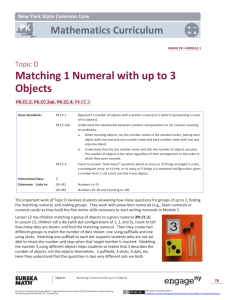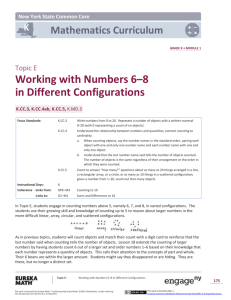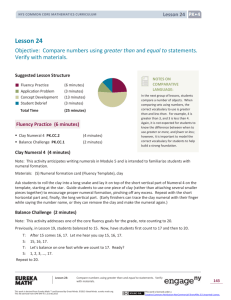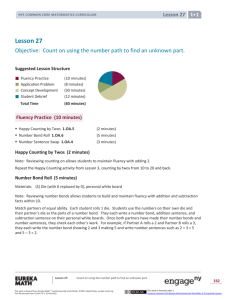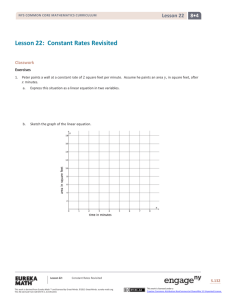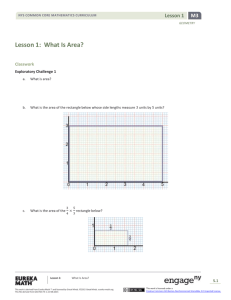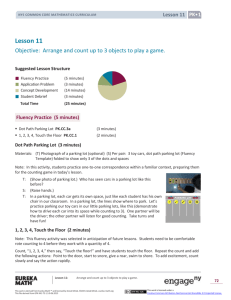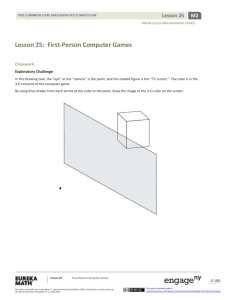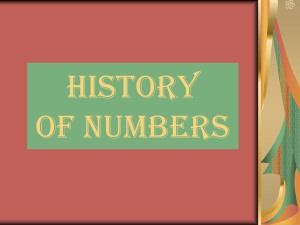Module Overview
advertisement
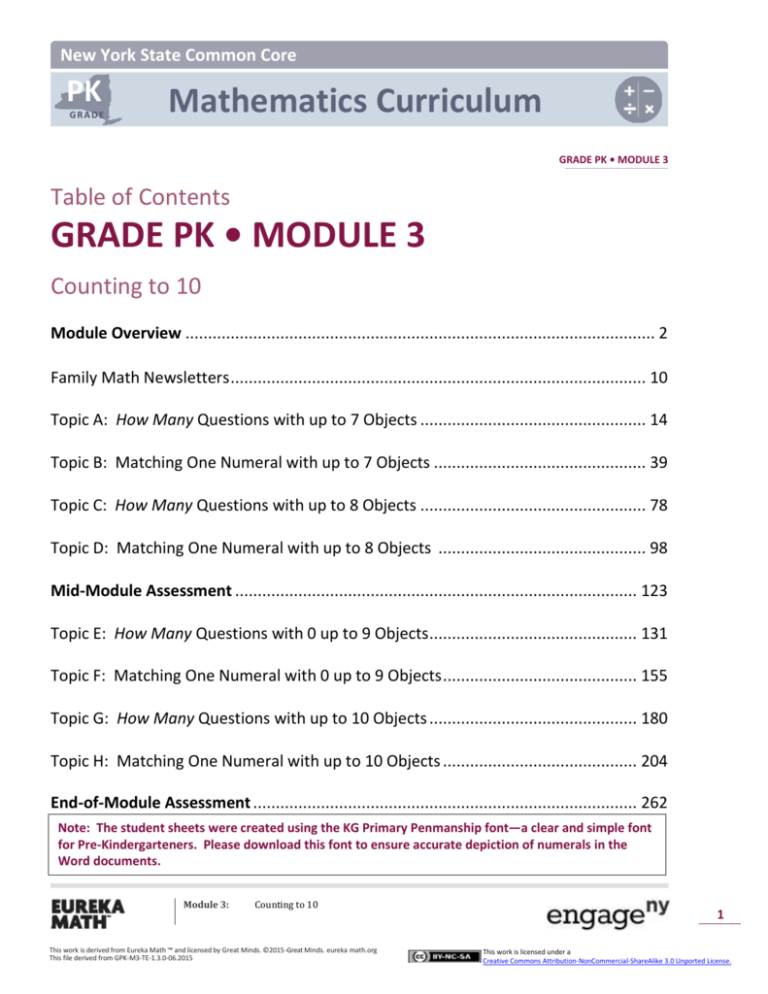
New York State Common Core PK GRADE Mathematics Curriculum GRADE PK • MODULE 3 Table of Contents GRADE PK • MODULE 3 Counting to 10 Module Overview ........................................................................................................ 2 Family Math Newsletters ............................................................................................ 10 Topic A: How Many Questions with up to 7 Objects .................................................. 14 Topic B: Matching One Numeral with up to 7 Objects ............................................... 39 Topic C: How Many Questions with up to 8 Objects .................................................. 78 Topic D: Matching One Numeral with up to 8 Objects .............................................. 98 Mid-Module Assessment ......................................................................................... 123 Topic E: How Many Questions with 0 up to 9 Objects .............................................. 131 Topic F: Matching One Numeral with 0 up to 9 Objects ........................................... 155 Topic G: How Many Questions with up to 10 Objects .............................................. 180 Topic H: Matching One Numeral with up to 10 Objects ........................................... 204 End-of-Module Assessment ..................................................................................... 262 Note: The student sheets were created using the KG Primary Penmanship font—a clear and simple font for Pre-Kindergarteners. Please download this font to ensure accurate depiction of numerals in the Word documents. Module 3: Counting to 10 This work is derived from Eureka Math ™ and licensed by Great Minds. ©2015 -Great Minds. eureka math.org This file derived from GPK-M3-TE-1.3.0-06.2015 1 This work is licensed under a Creative Commons Attribution-NonCommercial-ShareAlike 3.0 Unported License. NYS COMMON CORE MATHEMATICS CURRICULUM Module Overview PK 3 Grade PK • Module 3 Counting to 10 OVERVIEW Module 3 challenges students to build on their work with numbers through 5 to make sense of and count groups of 0, 6, 7, 8, 9, and 10 objects. Students also continue their work with the number core in the following ways (PK.CC.1–4): Rote counting (the number word list up to 15) One-to-one correspondence (one object paired with one number word from 0 to 10) Cardinality (how many in a set of up to 10 objects) Number recognition (matching written numerals 0, 6, 7, 8, 9, and 10 to quantities) Throughout the module, children participate in engaging experiences that help them make critical connections between these four understandings. In Topics A and B, students count and touch 1 object at a time (one-to-one correspondence) and recognize pre-written numerals up to seven. They build on their understanding of 5 to see 6 as 5 and 1 more and 7 as 5 and 2 more. Seven can also be seen as 6 and 1 more. The relationship of both 6 and 7 to 5 is emphasized in varied ways with materials: by a color change in two-sided counters after 5, by the addition of the thumb and index fingers of the right hand when counting left to right (i.e., Counting the Math Way), and by placing the sixth and seventh objects next to the first and second objects when making vertical 5 groups (see images below). These relationships are brought out within dynamic story contexts, for example, an explorer crossing a creek and chicks hatching from eggs in their nests. As in Module 1, students count objects arranged in varied configurations and, in Topic B, match quantities of six and seven to numerals. The pre-written numerals are not introduced until Topic B so that students have plenty of time to simply touch and count before matching the count to the abstract numeral. In this instructional sequence, students also answer how many questions, working through the configurations from simple to complex: linear, array, and circular (Pre-K children are not expected to count 6–10 objects in scattered configurations). Module 3: Counting to 10 This work is derived from Eureka Math ™ and licensed by Great Minds. ©2015 -Great Minds. eureka math.org This file derived from GPK-M3-TE-1.3.0-06.2015 2 This work is licensed under a Creative Commons Attribution-NonCommercial-ShareAlike 3.0 Unported License. NYS COMMON CORE MATHEMATICS CURRICULUM Module Overview PK 3 Using the familiar sunken pirate ship template and fish, students see that the cardinality of the set does not change when the same number of objects are rearranged. Decomposing and composing numbers follows the lesson on array configurations since the array is a natural place to begin seeing decompositions. “I see a pair here and another pair” leads to “I see two smaller groups inside 6. When I put the groups back together, I have 6 again!” The simple to complex sequence of lessons in Topics A and B, detailed above, is reiterated three more times in this module; Topics C and D focus on the number 8, Topics E and F on the numbers 0 and 9, and Topics G and H on the number 10 (PK.CC.3abc, PK.CC.4). More time is spent with the number 8 because it is the most challenging being 3 away from 5 and 2 away from 10. Likewise, more time is spent with the number 10 because it is foundational to place value understandings and numbers to 20. The Module culminates with students extending the number books they began with numbers 1 to 5 in Module 1, now adding the numbers 0 and 6–10. Module 3: Counting to 10 This work is derived from Eureka Math ™ and licensed by Great Minds. ©2015 -Great Minds. eureka math.org This file derived from GPK-M3-TE-1.3.0-06.2015 3 This work is licensed under a Creative Commons Attribution-NonCommercial-ShareAlike 3.0 Unported License. NYS COMMON CORE MATHEMATICS CURRICULUM Module Overview PK 3 Focus Grade Level Standards Know number names and the count sequence.1 PK.CC.1 Count to 20. Count to tell the number of objects. PK.CC.3 Understand the relationship between numbers and quantities to 10; connect counting to cardinality. a. When counting objects, say the number names in the standard order, pairing each object with one and only one number name and each number name with one and only one object. b. Understand that the last number name said tells the number of objects counted. The number of objects is the same regardless of their arrangement or the order in which they were counted. c. Understand that each successive number name refers to a quantity that is one larger. PK.CC.4 Count to answer “how many?” questions about as many as 10 things arranged in a line, a rectangular array, or a circle, or as many as 5 things in a scattered configuration; given a number from 1–10, count out that many objects. Foundational Standards (No standards have direct application as foundational in this Module.) Focus Standards for Mathematical Practice MP.2 Reason abstractly and quantitatively. Students match sets of 0 and 6–10 objects with numerals. MP.4 Model with mathematics. Students move a set of objects from linear to array and then to circular configurations. MP.6 Attend to precision. Students demonstrate precision by touching one object as they say one number word. Students also count precisely the Math Way when they lift their fingers off a surface and drop each finger as they count. MP.7 Look for and make use of structure. Students arrange objects in a line to expedite counting. They also use the 5-group formation to understand numbers 6–10 in relation to 5. 1 PK.CC.2 is addressed in Module 5. Module 3: Counting to 10 This work is derived from Eureka Math ™ and licensed by Great Minds. ©2015 -Great Minds. eureka math.org This file derived from GPK-M3-TE-1.3.0-06.2015 4 This work is licensed under a Creative Commons Attribution-NonCommercial-ShareAlike 3.0 Unported License. NYS COMMON CORE MATHEMATICS CURRICULUM Module Overview PK 3 Overview of Module Topics and Lesson Objectives Standards Topics and Objectives PK.CC.1 PK.CC.3abc PK.CC.4 A PK.CC.3ab PK.CC.4 PK.CC.1 PK.CC.3abc PK.CC.4 PK.CC.3ab PK.CC.4 B C D Days How Many Questions with up to 7 Objects Lesson 1: Introduce 6 and 7, and relate 6 to 5 and 1 more and 7 to 6 and 1 more. Lesson 2: Use linear configurations to count 6 and 7 in relation to 5. Lessons 3–4: Count to 6 and 7 left to right with fingers. Lesson 5: Count 6 objects in array configurations. Matching One Numeral with up to 7 Objects Lesson 6: Compose 6, and then decompose into two parts. Match to the numeral 6. Lesson 7: Compose 7, and then decompose into two parts. Match to the numeral 7. Lesson 8: Count 6 and 7 objects in circular configurations. Lesson 9: Arrange and count 6 and 7 objects in varied configurations. Lesson 10: Tally 6 and 7 objects. Lesson 11: Look at a numeral and count out a group of up to 7 objects. How Many Questions with up to 8 Objects Lesson 12: Introduce 8, and relate 8 to 7 and 1 more. Lesson 13: Use linear configurations to count 8 in relation to 5. Lesson 14: Count to 8 from left to right with fingers. Lesson 15: Count 8 objects in array configurations. Matching One Numeral with up to 8 Objects Lesson 16: Compose 8, and decompose into two parts. Match to the numeral 8. Lesson 17: Count 8 objects in circular configurations. Lesson 18: Arrange and count 8 objects in varied configurations. Lesson 19: Tally 8 objects. Lesson 20: Look at a numeral and count out a group of up to 8 objects. Mid-Module Assessment: Topics A–D (interview style assessment, 4 days) Module 3: Counting to 10 This work is derived from Eureka Math ™ and licensed by Great Minds. ©2015 -Great Minds. eureka math.org This file derived from GPK-M3-TE-1.3.0-06.2015 5 6 4 5 4 5 This work is licensed under a Creative Commons Attribution-NonCommercial-ShareAlike 3.0 Unported License. NYS COMMON CORE MATHEMATICS CURRICULUM Standards PK.CC.1 PK.CC.3abc PK.CC.4 PK.CC.3ab PK.CC.4 PK.CC.1 PK.CC.3abc PK.CC.4 PK.CC.3ab PK.CC.4 Module Overview PK 3 Topics and Objectives E F G H Days 5 How Many Questions with 0 up to 9 Objects Lesson 21: Introduce zero. Lesson 22: Introduce 9, and relate 9 to 8 and 1 more. Lesson 23: Use linear configurations to count 9 in relation to 5. Lesson 24: Count from 0 to 9 from left to right with fingers. Lesson 25: Count 9 objects in array configurations. Matching One Numeral with 0 up to 9 Objects Lesson 26: Compose 9, and decompose into two parts. Match numerals 0 and 9 to no objects and 9 objects. Lesson 27: Count 9 objects in circular configurations. Lesson 28: Arrange and count 9 objects in varied configurations. Lesson 29: Tally 9 objects. Lesson 30: Look at a numeral and count out a group of up to 9 objects. How Many Questions with up to 10 Objects Lesson 31: Introduce 10, and relate 10 to 9 and 1 more. Lesson 32: Use linear configurations to count 10 in relation to 5. Lesson 33: Count from 0 to 10 from left to right with fingers. Lesson 34: Count 10 objects in array configurations. Matching One Numeral with up to 10 Objects Lesson 35: Compose 10, and decompose into two parts. Match to the numeral 10. Lesson 36: Decompose numbers 6–10. Lesson 37: Arrange and count 10 objects in circular configurations. 5 4 8 Lessons 38–39: Count up to 10 objects in varied configurations. Lesson 40: Tally 10 objects. Lesson 41: Look at a numeral and count out a group of up to 10 objects. Lesson 42: Culminating Task—represent numbers 6–10 using objects, images, and numerals in a number book. End-of-Module Assessment: Topics E–H (interview style assessment, 4 days) Total Number of Instructional Days Module 3: Counting to 10 This work is derived from Eureka Math ™ and licensed by Great Minds. ©2015 -Great Minds. eureka math.org This file derived from GPK-M3-TE-1.3.0-06.2015 4 50 6 This work is licensed under a Creative Commons Attribution-NonCommercial-ShareAlike 3.0 Unported License. NYS COMMON CORE MATHEMATICS CURRICULUM Module Overview PK 3 Fluency New Fluency Topics Appearing in Module 3 Instruction Count 0–10 in different configurations Count one-to-one within 10 Make a group of 0 to 8 objects Rote count to 10 Within 8, find 1 more/1 less Familiar Fluency Count 1–5 in different configurations Count one-to-one within 5 Make a group of 1 to 5 objects Tally numbers 1–5 Within 5, find 1 more/1 less Terminology New or Recently Introduced Terms 0, 6, 7, 8, 9, 10 (numerals) Tally marks (lines used to record a count) Zero, eight, nine, ten (number words) Familiar Terms and Symbols2 1 less (e.g., 1 less than 7 is 6) 1 more (e.g., 1 more than 6 is 7) 1, 2, 3, 4, 5 (numerals) After (position word, e.g., “What comes after…?”) Count backward Count (with reference to use of number core) Counting the Math Way (count fingers from left pinky to right pinky) Different (characteristic used to analyze objects to match or sort) Exactly the same (characteristic used to analyze objects to match or sort) 2 These are terms and symbols students have seen previously. Module 3: Counting to 10 This work is derived from Eureka Math ™ and licensed by Great Minds. ©2015 -Great Minds. eureka math.org This file derived from GPK-M3-TE-1.3.0-06.2015 7 This work is licensed under a Creative Commons Attribution-NonCommercial-ShareAlike 3.0 Unported License. NYS COMMON CORE MATHEMATICS CURRICULUM Module Overview PK 3 Group (objects sharing one or more attributes) How many (with reference to counting quantities or sets) Line (with reference to counting configuration) Mark (with reference to starting point for count) Match (group items that are the same or that have the same given attribute) Number (numeral) One, two, three, … , seven (number words) Partners (embedded numbers) Shapes (rectangle, triangle, square, circle) Side (position or with reference to a shape) Sort (group objects according to a particular attribute) The same, but… (characteristic used to analyze objects to match or sort) Suggested Tools and Representations 10 puppies template (Lesson 37) 10-count egg cartons 2 cans of tennis balls or tennis balls template (Lesson 25) 6–7 picture cards (Lesson 9) Animal array cards (Lesson 34) Animal array template (Lesson 25) Bingo boards (Lesson 39) Circular configuration cards (Lessons 8, 17, 27, 37) Commercial concrete materials (e.g., linking cubes, blocks, foam shapes, tiles) Concrete materials (e.g., white beans spray painted red on one side, craft sticks, bags of twigs, dried leaves, seeds, dry pasta, plastic eggs, pennies, dimes, cotton balls, plates, forks, spoons, cups) Creek mat (Lessons 2, 13, 23, 32) Crown template (Lesson 17) Dominoes Dot cards 0–10 Dot cards in 5-group formation (Lesson 34) Double-sided counters (e.g., red and white) Flower template (Lesson 37) Number path Number stairs Number tower Numeral cards, 0–10 Nursery rhyme template (Lesson 25) Module 3: Counting to 10 This work is derived from Eureka Math ™ and licensed by Great Minds. ©2015 -Great Minds. eureka math.org This file derived from GPK-M3-TE-1.3.0-06.2015 8 This work is licensed under a Creative Commons Attribution-NonCommercial-ShareAlike 3.0 Unported License. Module Overview PK 3 NYS COMMON CORE MATHEMATICS CURRICULUM Objects 6–7 template (Lesson 8) Objects 6–8 template (Lesson 17) Ollie Octopus template (Lesson 12) Orange slice template (Lesson 31) Pairs of socks Partners of 6, 7, 8, 9, 10 puzzles (Lessons 6, 7, 16, 26, 35) Sets of numerals to 10 (cardboard, foam, etc.) Socks template (Lesson 15) Ten dot mat Underwater mat (Lesson 9) Wipe-off slates or personal white boards Scaffolds3 The scaffolds integrated into A Story of Units give alternatives for how students access information as well as express and demonstrate their learning. Strategically placed margin notes are provided within each lesson elaborating on the use of specific scaffolds at applicable times. They address many needs presented by English language learners, students with disabilities, students performing above grade level, and students performing below grade level. Many of the suggestions are organized by Universal Design for Learning (UDL) principles and are applicable to more than one population. To read more about the approach to differentiated instruction in A Story of Units, please refer to “How to Implement A Story of Units.” Assessment Summary Assessment Type Administered Format Standards Addressed Mid-Module Assessment Task After Topic D Constructed response with rubric (Numbers from 1–8) PK.CC.1 PK.CC.3abc PK.CC.4 End-of-Module Assessment Task After Topic H Constructed response with rubric (Numbers from 0–10) PK.CC.1 PK.CC.3abc PK.CC.4 3 Students with disabilities may require Braille, large print, audio, or special digital files. Please visit the website www.p12.nysed.gov/specialed/aim for specific information on how to obtain student materials that satisfy the National Instructional Materials Accessibility Standard (NIMAS) format. Module 3: Counting to 10 This work is derived from Eureka Math ™ and licensed by Great Minds. ©2015 -Great Minds. eureka math.org This file derived from GPK-M3-TE-1.3.0-06.2015 9 This work is licensed under a Creative Commons Attribution-NonCommercial-ShareAlike 3.0 Unported License.
